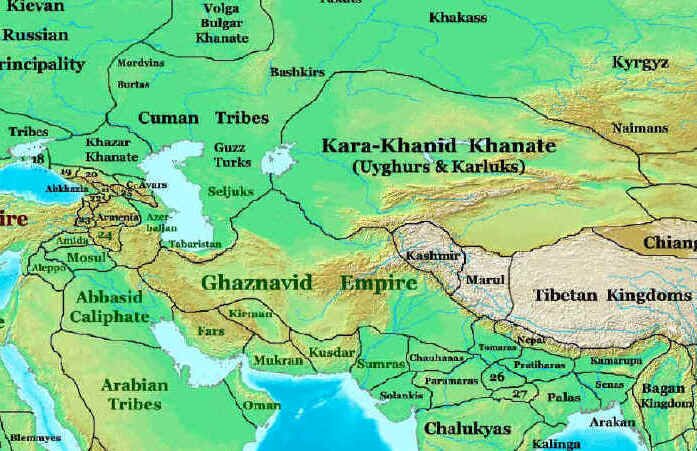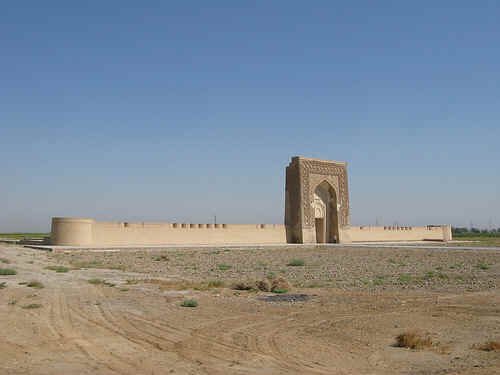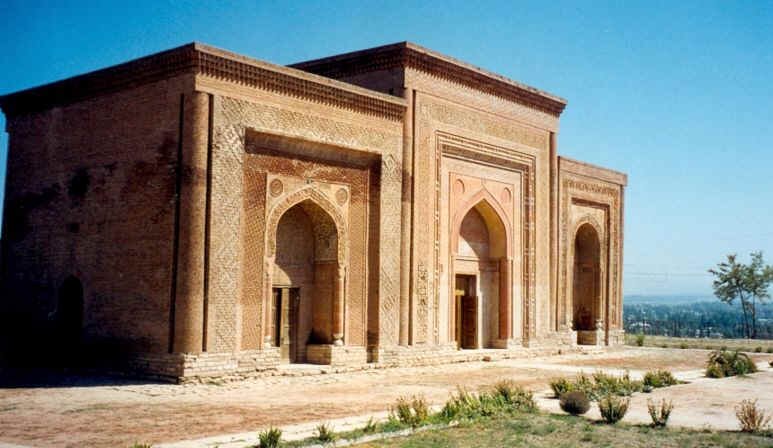| 6530 | Khanaat van de Karakhaniden (840 - 1212) |
|
 |
|
In 840 n.Chr. werden de Oejgoeren door de Kirgiezen uit hun gebieden in MongoliŽ verdreven. Een deel vestigde zich in het Tarimbekken en vermengden zich met de daar wonende bevolking. Hun rijk Kharakhoja, genoemd naar de gelijknamige legendarische held die de mensheid bevrijdde van het kwaad door een woeste draak te doden, bestond uit een confederatie van Boeddhistische staten. Een ander deel vestigde zich in TransoxaniŽ, bekeerden zich tot de Islam en stichtten het khanaat der Karakhaniden (Qarakhāniden). (kara = zwart en edel, khan = heerser), dat grensde in het zuiden grensde aan het rijk van de Ghaznaviden (962 - 1186), later het rijk van de Khwarezimiden
Ondanks hun verwantschap met Oejgoeren in Kharakhoja , meenden de Karakhaniden dat zij afstamden van de legendarische keizer Afrasiab (z. ook Samarkand). Hoofdstad van het rijk der Karakhaniden was Kashgar |
 |
|
In 999 Harun (or Hasan) Bughra Khan, grandson of the paramount tribal chief of the Uyghur-Karluk confederation, occupied Bukhara, the Samanid capital. The Samanid domains were split up between the Ghaznavids, who gained Khorasan and Afghanistan, and the Karakhanids, who received Transoxania; the Oxus River thus became the boundary between the two rival empires. During this period the Kara-Khanids were converted to Islam.
Early in the 11th century the unity of the Kara-Khanid dynasty was fractured by constant internal warfare. In 1041 Muhammad 'Ayn ad-Dawlah (reigned 1041Ė52) took over the administration of the western branch of the family, centred at Bukhara. After the rise of the Seljuks at the end of the 11th century in Iran, the Kara-Khanids became nominal vassals of the Seljuks. Later they would serve the dual suzerainty of both the Kara-Khitans to the north and the Seljuks to the south.[1] With a decline in Seljuk power, the Kara-Khanids in 1140 fell under domination of the rival Turkic[citation needed] Karakitai confederation, centred in northern China. 'Uthman (reigned 1204Ė11) briefly reestablished the independence of the dynasty, but in 1211 the Karakhanids were defeated by the Khwarezm-Shah 'Ala' ad-Din Muhammad and the dynasty was extinguished. Historically influential Kara-Khanid rulers include Mahmoud Tamgach of Kashgar. After the defeat of the Khitan dynasty by the Jin Dynasty (1115-1234) in Northern China, the great Khitan mandarin Yelu Dashi escaped from China with a small band of Khitan soldiers, recruited warriors from Tangut, Tibetan, Karluk, Kara-Khoja, Naiman areas and marched westward in search of asylum. Yelu Dashi was accommodated by the hospitable Tangut Western Xia Kingdom and the Buddhist Kara-Khojas. However, he was shut out by the Muslim Kara-Khanids near Gulja and Kashgar. Enraged, he subjugated Karakhanid states one by one and set up the Kara-Khitan suzerainty in Balasagun on the Chu River. Several military commanders of Kara-Khanid lineages such as the father of Osman of Khwarezm, escaped from Kara-Khanid lands during the Kara-Khitan invasion. In 1244, upon the invitation of the Egyptian Mamluks, Osman of Khwarezm marched on Jerusalem and liberated the holy city, on behalf of Islam, from the Crusaders. Invasie van Kara-KhitanThe Kara-Khitan Khanate, though harsh on the Muslim Turks, did not dispossess all of the Kara-Khanid domains. Instead, the Khitans (most of them were actually Naimans, Tanguts and Karluks speaking the same Turkic language as the Kara-Khanids) retreated to the northern steppes and had the Kara-Khanids act as their tax-collectors and administrators on Muslim sedentary populations (the same practice was adopted by the Golden Horde on the Russian Steppes). The Kara-Khitans even incorporated Kara-Khanid Muslim generals such as Muhammad Tai, who surrendered to the Naiman usurper Kuchlug at the end of the Kara-Khitan Dynasty. Kuchlug, the last ruler of the Kara-Khitan Dynasty, was especially harsh on the Muslim populations under his suzerainty. He went so far as to forcing conversions from Islam to Buddhism, the dominant religion of the ruling Kara-Khitans. The elite Kara-Khitans and their Naiman soldiers, on an interesting note, were very often Nestorian Christians, as suggested by the Syriac names of the Gur-Khans (Emperors), who at the same time had Confucian titles and patronized Buddhist establishments. Kuchlug's Naimans were perhaps largely Nestorian Christian. The reason for forced conversions to Buddhism was perhaps the underdevelopment of Nestorian institutions, making Nestorianism unsuitable as a tool for ruling sedentary populations. Val van het rijk der Karakhanidenn the early 13th century Kara-Khitan ruler Kuchlug, a sworn foe of Genghis Khan, was crushed by the advancing Mongol army along with his Kara-Khitan military state. His vassals, the Kara-Khanids, offered meager resistance to the Mongols. Kuchlug put an end to eastern part of Kara-Khanid state in 1211. Also, Khwarezmian Empire demolished western part of the Kara-Khanid state in 1212. |
Karakhaniden
Westelijke Karakhaniden
Oostelijke Karakhaniden
|
 |
Mausoleum van de Karakhaniden uit de 11e-12e eeuw in Uzgen, Kyrgyzstan. |
|
Gemaakt: 28-07-05 |